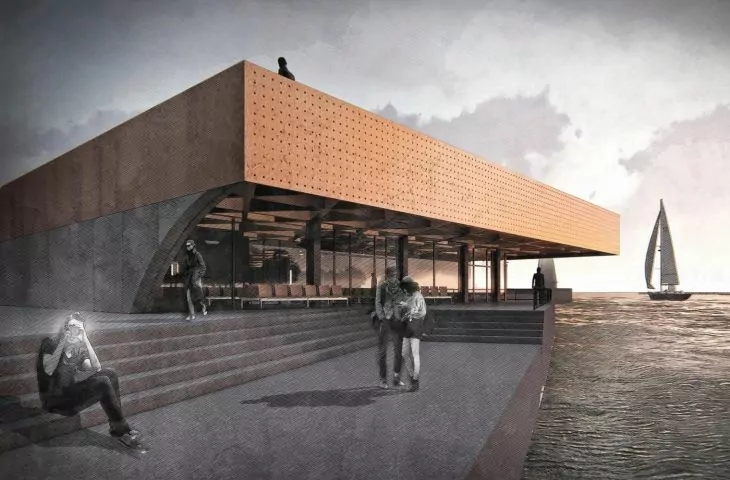Work submitted for the competition
"Best Diploma Architecture".
Gdansk is characterized by amazing architecture, unique atmosphere and enormous potential. The city is not only the largest agglomeration of the coast, but also a cultural and scientific center. Public transportation in Gdansk is mainly buses and streetcars, there is also a lesser-known streetcar line - water streetcars. However, the markings of their stations are not well visible, which makes it difficult to locate them. The lack of a convenient place to wait for a streetcar is also a big impediment.
The aforementioned issues and the analysis of the research problem became the pretext for addressing this topic in the work: for such spaces - year-round, functional and attractive - are needed.
The 


situation
© Alicja Jaroszek
A very interesting place, recently adapted for public use and having a water streetcar stop station in its area, is the West Breakwater in Gdansk - a structure built to protect the southern Baltic port from the destructive effects of waves. Its form promotes the use of the waterfront and facilitates the arrival of ships there, preventing them from being damaged. The area, due to its attractive location (it is the terminus of an extensive pedestrian and bicycle route with a beautiful view of the bay and the ships entering the port), quickly became a meeting place and a place for walks, both for local residents and tourists.



site development plan
© Alicja Jaroszek
Therefore, the design assumption is to make use of the existing area of the West Breakwater and incorporate in this place an object that is a continuation of the pedestrian route, leading from the seaside park and minimally interfering with the existing environment. Giving new architecture to the water streetcar stop, together with the development of the space around which the current condition is very rough, would contribute to the revitalization of the place in terms of space, functionality and communication.



bird's eye view
© Alicja Jaroszek
The new form of the station as , "Przystany - currents of history" will also be a source of information about Gdansk and its history. Thus, the functional program of the Przystani assumes the creation of a space for a water streetcar stop, as well as a gallery where archival photos of both this place and all of Gdansk will be displayed. Also significant for the design of the Marina is its direct contact with the water and the sweeping panorama. Maintaining the relationship between the architectural object and the spatial environment in which it will function is a leading issue.
Since water streetcar stops in Poland are seasonal facilities, and the streetcars themselves run only in the summer, with no other role besides transportation, "Marina - currents of history" will be a year-round object, thanks to the introduction of the gallery function.



view from inside
© Alicja Jaroszek
Its form is characterized by coastal elements and motifs. In particular, the circle motif is prominent, referring to windows in ships and boats. The second accent used is the motif of rusty metal sheets, very popular in Gdansk nowadays, resembling in color the red brick, so characteristic of the city's architecture. The appearance of the Marina itself refers to a ship entering the port, and thanks to the rounded ends of the designed facade, it brings to mind sea waves. The openwork of the block gives it lightness and makes it not overwhelming in its form.
The building, thanks to its expanded function and landscaping, will be an interesting point not only for travelers, but also for residents of Gdansk and tourists. The idea could also be replicated in other stations in the city, accentuating fragments of the history of a place and allowing them to be actively present in the minds of the public.
{tag:studenci}
Illustrations: © Author

































